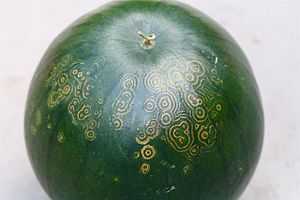Watermelon mosaic virus facts for kids
Quick facts for kids Watermelon mosaic virus |
|
|---|---|
 |
|
| Ring spots on watermelon caused by Watermelon mosaic virus | |
| Virus classification |
|
| (unranked): | Virus |
| Realm: | Riboviria |
| Kingdom: | Orthornavirae |
| Phylum: | Pisuviricota |
| Class: | Stelpaviricetes |
| Order: | Patatavirales |
| Family: | Potyviridae |
| Genus: | Potyvirus |
| Species: |
Watermelon mosaic virus
|
The Watermelon mosaic virus (WMV) is a tiny plant virus that causes a disease called "watermelon mosaic disease." This virus can infect many different plants, not just watermelons! It's also known by other names like Marrow mosaic virus or Melon mosaic virus. Until recently, it was often called Watermelon mosaic virus type 2, or WMV-2.
WMV is a type of virus that has a single strand of RNA, which is like its genetic instruction manual. This RNA is protected by a protein shell. Scientists believe WMV came from a mix of genetic material from other plant viruses, like Soybean mosaic virus and Bean common mosaic virus.
Contents
What is Watermelon Mosaic Virus?
WMV is part of a group of viruses called potyviruses. These viruses look like long, flexible rods, about 760 nanometers long. To give you an idea, a nanometer is one billionth of a meter, so these viruses are super tiny!
WMV is similar to other plant viruses that affect crops, such as Zucchini yellow mosaic virus (ZYMV) and Papaya ringspot virus (PRSV). When WMV infects a plant, it creates special structures inside the plant's cells. These structures can damage the plant's tissues.
How Does WMV Spread?
The main way WMV spreads is through tiny insects called aphids. Aphids are small bugs that feed on plant sap. As they move from one plant to another, they can pick up the virus and carry it to new, healthy plants.
At least 29 different kinds of aphids can spread WMV, including common ones like Aphis gossypii and Aphis craccivora. When an aphid lands on an infected plant, it can quickly pick up the virus. Then, it can spread the virus to a new plant within just a few hours.
WMV is found in many places around the world, especially in warmer areas. It causes big problems for farmers who grow plants like:
- Cucurbits (like watermelons, squash, and cucumbers)
- Legumes (like peas and beans)
- Malvaceous plants (like okra)
- Chenopodiaceous plants (like spinach)
What Plants Can WMV Infect?
Watermelon mosaic virus is famous for infecting most plants in the cucurbit family, as well as some legumes. However, scientists have found that it can infect more than 170 different types of plants from 27 different plant families! This makes it one of the viruses with the widest range of hosts.
What Are the Symptoms of WMV?
The signs of WMV infection can look different depending on the plant, the type of virus, and even the weather. But the main things to look for are:
- Mottling: This means the leaves have patchy, uneven colors, often light and dark green spots.
- Mosaic patterns: This looks like a mix of different colors, similar to a mosaic artwork.
Here are some examples of what WMV can do to different plants:
- On Cucurbita pepo (a type of squash), you might see mosaic patterns and leaves that are shaped unusually.
- On Pisum sativum (peas), the plant might develop dark spots, mottling, and tissue damage.
- On Citrullus lanatus (watermelons), the fruit can become twisted or misshapen, and the leaves might show mosaic patterns.
Other common symptoms include yellow rings on leaves, bumpy leaves, and bright green mosaic patterns. Scientists sometimes use specific plants like Nicotiana benthamiana or Chenopodium amaranticolor to help identify the virus because of the clear symptoms they show.
How Can We Control WMV?
Controlling WMV is important to protect crops. Here are some ways farmers try to manage it:
Preventing Aphid Spread
Since aphids are the main way WMV spreads, controlling them is key.
- Pesticides: Farmers can use special sprays to reduce the number of aphids. However, these sprays work best as a preventative measure. If the virus is already in the field, aphids might still spread it to new plants before the pesticides kill them.
- Mineral oil sprays: These sprays can make it harder for the virus to be transmitted by aphids.
Other Control Methods
- Crop rotation: This means planting different types of crops in the same field each season. This can help break the cycle of the virus and reduce its spread.
- Removing infected plants: If only a few plants are infected, removing them quickly can help stop the virus from spreading to healthy plants.
How Do Scientists Identify WMV?
It can be hard to tell what virus is causing a plant disease just by looking at the symptoms, because many viruses cause similar mosaic patterns. Farmers usually don't have the special tools needed to identify the exact virus.
However, companies have created special kits that can help identify WMV-2 and other viruses. One common test is called ELISA (Enzyme-linked immunosorbent assay). This test uses special antibodies that can find and recognize the WMV virus. Scientists can also use a method called RT-PCR to detect the virus's genetic material.

